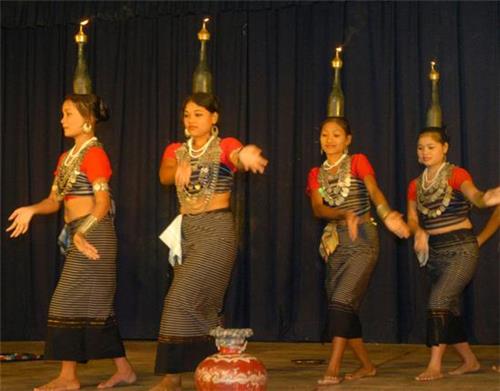Culture Of Tripura
Tripura has several diverse ethno-linguistic groups, which has given rise to a composite culture. The dominant cultures are Bengali, Manipuri, Tripuris, Jamatia, Reang, Naitong, Koloi, Murasing, Chakma, Halam, Garo, Hajong, Kuki, Mizo, Mogh, Munda, Oraon, Santhal, and Uchoi.

Culture of Tripura is distinct and a bit similar to other people of Northeast India. However like Assam, Manipur, Burma and Southeast Asia culture of Tripura is characterized in small portion where people live in plain and hill areas. Tripura is a state in North East India. In the 2001 census of India, Bengalis represented almost 70% of the population and the Tripuri population comprised 30% of Tripura's population. The Tripuri population (indigenous population) comprises some clans and ethnic groups with diverse languages and cultures. The largest native group was the Tripuri who had a population of 543,848 in 2001 census,[1] representing 16.99% of the state population and 54.7% of the scheduled tribe population.[1] The other group of people in order of decreasing population were Chakma (6.5%), Halam (4.8%), Mog (3.1%), Munda, Kuki tribes and Garo Hajong. Bengali is the most spoken language, due to the dominance of Bengali people in the state. Kokborok (Tripuri/Tiprakok) is a common language among Tripuris and lingua franca among tribes. Several other languages belonging to Indo-European and Sino-Tibetan families are spoken by the different tribe. A young Tripuri woman wearing rigwnai and risa Some fashion types that are woven in the rignai borok by Tripuri women are as follows: Anji Banarosi Chamthwibar Jirabi Khamjang Khumbar Kuaiphang Kuaichu Kuaichu bokobom Kuaichu ulta Malibar Miyong Muikhunchok Monaisora Muisili Natupalia Phantokbar Sada Salu Similik yapai Takhumtei Temanlia Thaimaikrang Thaiphlokbar Tokbakbar Tokha Toksa Toiling Toprengsakhitung Rignaichamwthwi Rignai mereng Metereng trang Rignai khamchwi Kwsakwpra Rignaibru Rignaikosong Kwsapra Songkai Sorbangi It is said that at the time of Subrai Raja, the most famous and legendary King of Tripura, through his 250 wives he had invented 250 designs of rignai. He married those women who invented a new design. But all these designs have been lost over time and only a few remain. An effort to rediscover the lost designs is in process. The male counterpart for the loin area is rikutu and for the upper part of the body is the kamchwlwi borok. Today, however, very few men wear this style of dress except in rural Tripura and by the working class. Males have adopted more modern dress.